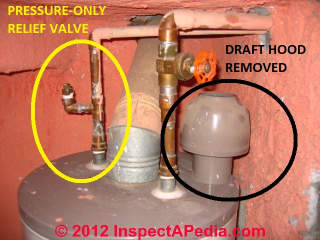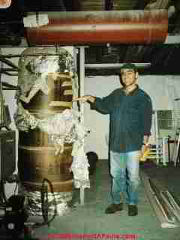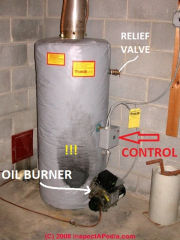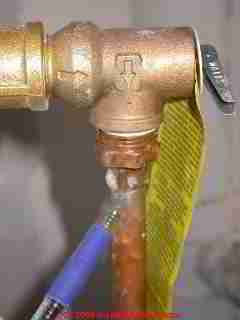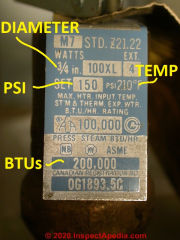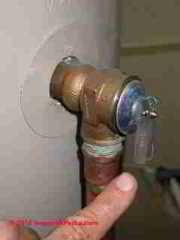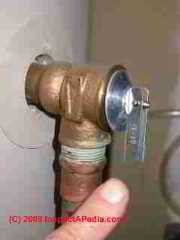 Hot Water Heater Temperature Pressure Relief Valves
Hot Water Heater Temperature Pressure Relief Valves
Inspect, install, repair calorifier, geyser, hot water cylinder
- POST a QUESTION or COMMENT about water heater pressure/temperature relief valves or TP valves on water heating appliances
Water heater safety valves, TPRs, pressure relief valves, gas shutoff valves:
Here at we discuss temperature and pressure relief valves used on residential water heaters. We explain the function, inspection, and maintenance of temperature & pressure relief valves on water heaters used to produce hot water for washing and bathing.
We describe how to diagnose and cure just about every problem with T&P valves on water heaters and we describe how to inspect the hot water supply system for unsafe or improper Temperature & Pressure Relief Valve installation.
InspectAPedia tolerates no conflicts of interest. We have no relationship with advertisers, products, or services discussed at this website.
- Daniel Friedman, Publisher/Editor/Author - See WHO ARE WE?
Water Heater Temperature & Pressure Relief Valves
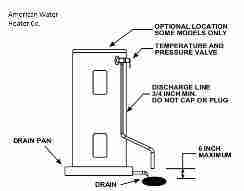 How to fix or replace leaky water heater relief valves.
How to fix or replace leaky water heater relief valves.
Here we provide ANSI and water heater standards and advice: water heater relief valve requirements. Water heaters: how to inspect, test, adjust, repair, and choose among types of hot water heaters.
[Click to enlarge any image]
We offer suggestions for Testing the Water Heater Temperature Pressure Relief Valve (TP Valve or "Safety Valve" or T&P valve or TPR valve) on a Water Heater.
We also describe Water Heater Safety Inspections - how to check the TP Relief Valve, and we warn about BLEVEs: Boiling Liquid Expanding Vapor Explosions at Water Heaters (or heating boilers).
The standard opening pressure for TPR valves on residential water heaters is usually 150 psi.
Most water heater tanks (cylinders, geysers, calorifiers) also have a standard operating pressure of 150 psi.
The standard maximum temperature rating for a TPR valve is usually 210°F.
Watch out: Under no circumstances should the relief valve setting of the valve exceed the working pressure of the tank, as this would violate all heater warranties and codes. (Watts 2011)
Article Contents
- RELIEF VALVE, WATER HEATER - home
- WATER HEATER TPR VALVE REQUIRED
- WATER HEATER TPR VALVE INSTALL
- WATER HEATER TPR VALVE LEAK DIAGNOSIS
- WATER HEATER TPR VALVE SIZE
- WATER HEATER TPR VALVE EXPLOSIONS
- WATER HEATER TPR VALVE for WATER HEATER DRAINING
- WATER HEATER TPR VALVE TEST
- WATER HEATER TPR VALVE TEST SCHEDULE
- WATER HEATER SAFETY DEVICES, OTHER
- WATER HEATER PRESSURE-ONLY RELIEF VALVES
Requirement for Installation of Water Heater T&P Valves
To reduce the risk of abnormally high and dangerous pressures in the hot water system and to reduce chances of a dangerous explosion, water heater manufacturers, building codes, and independent standards require that a temperature and pressure relief valve be installed on the water heater - a T&P Relief Valve.
[Click to enlarge any image]
The tag providing information on any T&P relief valve describes its operating pressure and temperature rating.
The T&P Valve installed on your water heater must be marked with a "set pressure" (the pressure at which the valve will open to relieve pressure) must be equal to or less than the maximum working pressure of the water heater.
The Temperature/Pressure Relief valve installation sketch shown at left is from American Water Heater Company's installation guide. [1]
Other Versions of Pressure or Temperature & Pressure Relief Valves on Water Heaters
The funny little device on the elbow seen at the left hot water riser on this water tank is in common use in Mexico.
Covered-Over relief valves:
The relief valve on this water heater has been covered by owner-installed water heater insulation.
This is an unsafe condition as the operation of the temperature or pressure relief valve may be interfered with by the insulation and also because the valve cannot be inspected for evidence of leaks or failure.
T&P Valve Installation Location, Position, & Drain Discharge Line Routing Rules
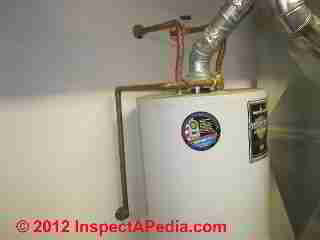 Proper location for water heater TP relief valve
Proper location for water heater TP relief valve
The water heater temperature/pressure relief valve is installed into an opening directly on the water heater at a location marked for that purpose, usually at or near the top of the heater (where water temperatures will be greatest).
Watch out: for these unsafe water heater relief valve or pressure-only relief valve installation mistakes [10]
- Do not depend on a pressure-relief only valve
(no temperature response) to protect a hot water heating system.
For conventional residential and commercial water heaters of size 15L (4 US Gal) and larger, a pressure relief alone cannot prevent a water heater tank explosion.
See BLEVE EXPLOSIONS for details.
Pressure relief valves are only intended for protection of tanks that are not heated - such as a well water pressure tank or a cold water storage tank. Where a pressure-only relief valve is to be used it should be installed as close as possible to the equipment it's protecting. - Shutoff valves
should never be installed between a relief valve and the tank it is designed to protect - The operating pressure and temperature rating
of a temperature/pressure relief valve must be matched to the input BTUh, temperature and pressure capacity of the calorifier, geyser, water heater and its physical volume.
For example, a typical residential water heater TPR valve operates to provide:
Temperature Relief: 210°F (99°C)
Pressure Relief Range: 75 to 150 psi (5.2 to 10.3 bar).
Has a 3/4" ID NPT water outlet whose hot water must be piped to a visible and safe location, protected from freezing
On some very small point of use electric water heaters (1.5 - 3 KW heating capacity, and up to 15L / 5 USG water capacity) the relief valve may operate only on pressure and may be set to open at 6 bar (87 psi).
Reader Question: Red Tagged Water Heater Safety Issues: water heater discharge tube
(Mar 7, 2013) Christian said:
Question: I went and looked at a house today. On the water heater, there was a tag, it was red and white. It stated "notice of unsafe condition". However on the check boxes there was nothing checked IE stuff like CO or ignition risk. However, on the bottom it said "no water, copper through floor".
What does this mean? the house is vacant and has been for some time. Thanks
Reply:
Christian, Without some photos or other details, I don't know, but I speculate that if the discharge tube on the relief valve is piped down through the floor to a non-visible location, that's improper & unsafe and may be what the tagged meant.
Proper Temperature & Pressure Relief Valve Size for Water Heaters
All pressure/temperature relief valves include a tag or label that indicates the valve discharge capacity in BTUs - heat energy discharge rate. The installation or technical data or data tags for all modern water heaters include the water heater's BTU input rate capacity (and some indicate the specifications for the TP valve too.)
The Temperature/Pressure relief valve for a water heater must have a BTUh discharge rate (BTUs per unit time, such as BTUs per hour) that is equal to or greater than the BTU input rate of the heating appliance the valve is supposed to be protecting. [10]
As we discuss
at BLEVE EXPLOSIONS, it is the release of heat (or "temperature" or "energy") that prevents a water tank from exploding when it is being overheated, not the release of pressure.
Details about the required relief valve size are
at WATER HEATER TPR VALVE SIZE.
Proper position for water heater TP relief valve & working space for inspection & repair
The Temperature/Pressure relief valve mouth must point down, and a 3/4" I.D. (or greater) discharge tube must be attached to the T&P Valve's opening and routed down close to but not touching the floor level, typically near a floor drain and stopping 6" above the floor.
This permits emergency hot water to be discharged without risk of burning the face and body of a bystander.
Our photo above illustrates a T&P valve installed on the water heater top and connected to a discharge tube that passes outside the building through the wall.
This Tucson Arizona home installation disposes of any water heater T&P discharge outside to about 6" from the ground surface - not to a hidden location. And because there is no freeze risk in this climate the local installation was approved.
T&P valve discharge tubes are permitted to discharge below the floor of a structure but should not be piped to a hidden location where you won't notice that the valve is dripping or leaking.
Never close off or block the discharge opening of the discharge tube, just as you wouldn't plug the discharge opening of the T&P valve itself.
Reader Question: (Aug 21, 2014) Julie said: minimum clearance distance for TPR valve on heater under counter top
I have a hot water heater with the temperature relief valve on the top. It is a short 30-gal water heater that is under a counter top.
What is the minimum clearance distance that is required from the bottom of the countertop to allow the temperature relief valve adequate clearance? Is there a code spec for this?
Reply:
Julie a look at installation details for TP valves on water heaters didn't come up with an over-head clearance, though some common sense would indicate you'd need enough space for the test lever to be operated AND enough space to remove and replace the valve when needed.
Since a top-mounted TP valve has a temperature sensing stem that protrudes downwards into the water heater the removal space will be more than you think
On a small water heater (cylinder) the extension of the sensor is about 3" while on larger water heater cylinders that added length could be as much as 9" below the inlet.
Adding that 9" of sensor to the TP valve body and lever height (anywhere from 5 5/8" to 9 1/4") means the minimum (for the smallest valve size) valve total length is about 9" and the larger valve could be much larger.
Now we can slightly tip a valve to get it out of the heater, buy - I'd like to see 12" or more to give both working space and space to remove the valve.
Relief valve missing its discharge tube
or drip line, also called an extension tube: this is an unsafe condition - someone may be scalded should the relief valve open.
Relief valve installed through an elbow, coupling, or pipe nipple:
do not install a temperature & pressure relief valve through any intermediary plumbing fittings. Doing so can cause the T&P valve to fail to operate safely when it should. For example, an air pocked in a coupling can prevent proper sensing of water temperature.
We inspected a hot water tank installation at which the installer actually cut off the temperature sensing probe from the T&P valve so that he could install it through an elbow. This was a stupid and dangerous modification. - Ed.
Constricted, Under-sized, or Mis-Routed Relief Valve Discharge Tubes are also dangerous.
The discharge tube attached to the water heater pressure/temperature relief valve should be the same diameter as the opening of the valve itself. In our photo someone has fastened a 1/2" pipe discharge tube onto a 3/4" diameter relief valve.
See a complete catalog of water heater TPR valve drain piping specifications & defects
at RELIEF VALVE DISCHARGE TUBE
Leaky or Dripping Water Heater Pressure & Temperature Relief Valves
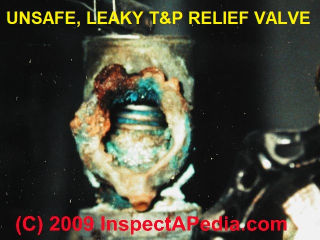 Evidence of dangerous leaks and corrosion at water heater temperature/pressure safety valves is discussed here.
Evidence of dangerous leaks and corrosion at water heater temperature/pressure safety valves is discussed here.
Watch out: As our photo shows (above left), mineral salts left behind as hot water evaporates from the mouth of a pressure or temperature relief valve can completely clog the spring that is intended to allow the relief valve to open under excess (unsafe) pressure.
This relief valve needs to be replaced immediately and the cause for the valve's leakage also needs to be determined.
Where to find a List of Causes of Leaky Relief Valves or TP Valves on Water Heaters or Hot Water Storage Tanks
Temperature & Pressure Relief valves may open, leak, or drip for a variety of reasons that we list and explain in detail
at RELIEF VALVE LEAKS. You should review that article. But here we list some common water heater relief valve leak causes:
- Water temperature:
the water heater temperatures are excessive. In this case the TP valve is doing its job - find and fix the cause of too-high water temperatures in the system. - Incoming water pressure:
the building water supply pressure is too high (over about 70 psi) or periodically water pressure fluctuates and is too high at times - Thermal expansion of water:
Periodic discharge of the temperature and pressure relief valve may be due to thermal expansion in a closed water supply system.
Thermal expansion of water ncreases in a closed system if there is a stop valve or a check valve installed close to the water heater.
The increase in plumbing system pressure to a level that opens the TP valve is called "thermal expansion pressure". Watts suggests installing a bypass model water pressure regulator that lets the excessive pressure head back to the street main or building water supply system - a solution that only works if the supply pressure is lower than the T&P relief valve spill pressure - which it usually is.
See THERMAL EXPANSION of HOT WATER for further explanation of the actual amount of expansion that occurs in heated water.
and
See HOT WATER EXPANSION TANKS for a solution for water heaters. Details are
at THERMAL EXPANSION TPR VALVE LEAKS for an explanation of how thermal expansion of hot water causes relief valve leaks and how to fix the problem.
A closed water system with thermal expansion and no means of relief can cause leaks at the pressure/temperature relief valve, such as- on a hot water heater with some building piping arrangements
- on a hot water heating boiler at which its expansion tank has become waterlogged - Also
see EXPANSION TANKS for diagnosis & repair procedures
- Dirt or debris in the TPR valve
are preventing proper closure of the relief valve valve - A deteriorated TPR valve gasket
inside the relief valve or corrosion on the valve seat can cause leaking at the valve; we find this mess occurring when someone lifts the "test lever" on a older P/T valve that has not been tested or operated for some time.
A brittle piece of gasket can be spit out of the valve and it will then keep leaking.
- The T&P valve is installed on a sidearm gas heater that is causing an overheat condition at the sensor point of the valve
This thermal expansion is discussed
at GAS SIDEARM COIL SPECIAL PROBLEMS - Water hammer:
water hammer or "banging pipes" can also be a source of relief valve drips and leaks. Water hammer causes a momentary very high pressure in the water piping system, sufficient to open a TPR valve for a brief time.
See WATER HAMMER NOISE DIAGNOSE & CURE
Watch out: a dripping or frequently spilling T&P valve is dangerous because those very leaks can eventually cause the valve to clog and then to fail to open when it should.
The result cause dangerous, even
fatal BLEVE EXPLOSIONS
Even without a BLEVE explosion, sudden leaks of very hot water can cause scalding burns on anyone nearby, and in some situations can be fatal:
In 2020 five people, including a child, were killed after a hot water pipe exploded during the night, flooding a basement room with boiling water. The accident occurred on 20 January 2020 in the Mini Hotel Caramel, located in the basement of a residential building in Perm, Russia. - "Around the World", The Times of India, Times Global section, l p. 1, 21 January 2020. The Times added that at least three other people were hospitalized in the accident.
Is Dripping From a Water Heater Relief Valve Acceptable?
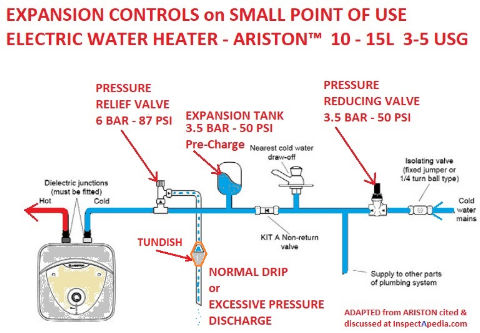 Generally, no, not on a heating boiler nor on a typical residential water heater tank larger than 15L (5 USG), for the reasons we listed just above.
Generally, no, not on a heating boiler nor on a typical residential water heater tank larger than 15L (5 USG), for the reasons we listed just above.
However there is at least one exception: it may be "normal" to see dripping from the relief valve of certain small 2-5 gallon point of use electric water heaters.
Some small point-of-use water heaters, such as some of Ariston's Andris Lux point of use electric storage water heaters, include this statement in the water heater's IO Manual:
14. It is normal that water drip from the overpressure safety device and
EN 1487 safety unit when the appliance is heating.
For this reason
one must install a drain, open to the air, with a continuously
downwards sloping pipe, in an area not subject to subzero
temperatures.
Make sure to drain the appliance when it is out of
service or in an area subject to subzero temperatures. - Source: Ariston unvented water heater IO manual cited below.
Watch out: for safety, to recognize that a water heater relief valve is leaking, the installation of a tundish is important. See details
at TUNDISH used in PLUMBING
Watch out: As our we cited above, mineral salts left behind as hot water evaporates from the mouth of a pressure or temperature relief valve can completely clog the spring that is intended to allow the relief valve to open under excess (unsafe) pressure. Ariston recommends that the water heater shown here be protected from hard water (water high in mineral content).
- ANDRIS LUX WATER HEATER IO MANUAL [PDF] Ariston Thermo S.p.A. Viale Aristide Merloni, 45 60044 Fabriano (AN) Tel. (+ 39) 0732 .6011 ariston.com retrieved 2020/04/12, original source: Ariston, Op. Cit., https://www.ariston.com/uk/Electric_Water_Heaters/media/files/830_Andris%20Lux%20UK%20Manual%202017.pdf
Accidental or deliberately plugged Temperature & Pressure Relief Valves
 The discharge opening of a TPR Valve must not be blocked or
reduced in size under any circumstance. [1] [2]
The discharge opening of a TPR Valve must not be blocked or
reduced in size under any circumstance. [1] [2]
Technical note: why must the TP Valve point "down"? Take a look at the photo above. If a relief valve is dripping the deposit of minerals inside the valve will accumulate still more rapidly if the valve points to the side or upwards.
The result is a clogged valve as we explain above - a dangerous situation that risks an explosion.
Watch out: Never remove nor plug a pressure/temperature relief valve.
This [water heater pressure/temperature relief] valve must be marked with the maximum set pressure not to exceed the marked maximum working pressure of the water heater.
Install the valve into an opening provided and marked for this purpose in the water heater, and orient it or provide tubing so that any discharge from the valve exits only within 6 inches above, or at any distance below, the structural floor, and does not contact any live electrical part.
At RELIEF VALVES - TP VALVES we explain that in the photograph above where you see the plaster wall and the foam insulation sprayed around the lever, these form blockages of the test lever on the TPR valve.
Watch out: If the lift/test lever on a temperature/pressure relief valve is blocked from movement that prevents the valve from being tested - a step recommended at least annually by relief valve manufacturers.
Watch out: Depending on the relief valve model and design, a blocked relief valve test lever may prevent the valve from opening in response to pressure or temperature:
Details are
at RELIEF VALVE, TP VALVE TEST
What is the Proper Size & Rating for Temperature/Pressure Relief Valves on Water Heaters?
 Watch out: A Temperature / Pressure Relief Valve on a water heater must have a BTU or heat spillage release capacity greater than the BTU input rating of the water heater. Otherwise even if the valve opens it can't release heat fast enough and there is a real risk that the water heater could explode.
Watch out: A Temperature / Pressure Relief Valve on a water heater must have a BTU or heat spillage release capacity greater than the BTU input rating of the water heater. Otherwise even if the valve opens it can't release heat fast enough and there is a real risk that the water heater could explode.
The pressure-relief component of a TP valve or of a separate additional pressure-relief valve should be at least 20 to 30 psi above the maximum working pressure in the system. Otherwise you will find occasional "nuisance dripping" at the relief valve due to normal water pressure variations or due to water hammer.
Shown here: a water heater TPR valve data tag capable of 15,000 BTUh energy release.
[Click to enlarge any image]
The standard opening pressure for TP valves on residential water heaters is usually 150 psi, and most water heater tanks also have a standard operating pressure of 150 psi.
The standard maximum temperature rating for a T&P valve is usually 210°F.
If the building water supply pressure is above 125 psi, Watts recommends that a pressure-reducing valve be installed to reduce pressure to 40-45 psi so that a standard TP valve set can be used.[10]
CSA Temperature Steam Rating The CSA temperature steam rating, the method used under ANSI standard Z21.22, used nationally for sizing relief valves.
The rating is obtained initially on a test tank where 15psi of steam pressure is accumulated.
Under these conditions, the thermostat has opened the valve, and the steam flows through the orifice into an accumulating tank where it is measured and translated into a valve rating.
This is the safest form of rating relief valves because it takes into consideration the fact that no water pressure is available to the heater.
Therefore, it covers all
potential elements that could affect the
relieving capacity. - Watts (2011) cited
at RELIEF VALVE, TP VALVE TEST
Note: we recommend that for most conditions residential water pressure inside the building should not exceed 70 psi. We observe an increase of leaks and drips at faucets and toilets at higher building pressures as the pressure may exceed the design pressure of some plumbing fixtures.
See WATER PRESSURE REDUCER / REGULATOR.
Watch out: as we discuss above, dripping TP relief valves are unsafe. The hazard is that minerals in the water supply accumulate inside the valve during the passage of hot water through the valve assembly.
That accumulation of scale will eventually block operation of the relief valve, causing the relief valve to fail to operate properly if unsafe pressure or temperature occurs in the water heater in the future. The risk, ultimately, is a water heater tank or heating boiler explosion.
Question: what relief valve would be used on a 40 gallon water heater?
2020/11/15 levi said:
what is the difference? and what is commonly used on a 40 gallon water heater?
Moderator reply: water heater relief valve standard specifications: relief valve pressure, temperature, size
Levi:
Sorry I don't get all of your question, but let me offer this:
The TPR valve selected depends on the type of heating appliance and its fuel and thus the operating temperature range and pressure range.
Water Heater Relief Valve Opening Specifications
- Open at 150 psi pressure
- Open at 210 degF temperature
Water Heater Relief Valve Energy Release Capacity: BTU Ratings
The water heater relief valve must be capable of discharging energy (as BTUs) at a rate greater than the input rate of the water heater's energy source
To simplify life you'll typically find TPR valves sold in BTU capacity ranges
- A group for heaters rated at Under 200,000 BTU Per Hour Input Rating
- A second group for heaters rated at Over 200,000 BTU Per Hour Input Rating
You can easily verify the TPR valve on your 40 gallon water heater by looking at the information on the relief valve data tag and comparing that with the INPUT BTUH rating of your water heater.
Water Heater Relief Valve Minimum Starting Water Pressure
Watch out: the typical water heater relief valve capacity rating and sizing charts assume that the heater is supplied with water at no less than 30 psi.
Why is this important?
Because very low supply pressure means low pressure in the water heater tank which means that the valve may not open even at unsafe water temperatures or pressures for the equipment installed in your home.
Water Heater Relief Valve Minimum Opening Size or Diameter
 Shown here: a Cash Acme water heater relief valve package giving the valve's specifications. From the price you can tell this came from our archives, not from a recent purchase.
Shown here: a Cash Acme water heater relief valve package giving the valve's specifications. From the price you can tell this came from our archives, not from a recent purchase.
Water heater relief valves must be listed or approved for their use according to the standards accepted by the country where you live. In North America those are SME, ANSI and CSA (AGA) standards.
- Watts WATER HEATER TEMPERATURE & PRESSURE RELIEF VALVE SELECTION CHART [PDF] (1996) Watts Regulator, Water Product Division, Safety & Control Valves, retrieved 2020/11/15 original source: http://media.wattswater.com/F-SF.pdf
Excerpts:
For gas, electric or oil storage water heaters under 200,000 BTU/hr. rating and for compliance with any applicable water heater labeling requirements: Use 3⁄4" T&P Valves tested under ANSI Z21.22 with ratings as certified and listed by CSA.
For gas or oil-fired storage water heaters between 200,000 and 730,000 BTU/hr.rating; and for compliance with any appli-cable water heater labeling requirements: Use 1" and over T&P valves tested under ANSI Z21.22 with ratings as certified and listed by CSA.
For ASME installations of gas or oil-firedhot water supply boilers heating domestic water for a storage tank over 730,000 BTU output; and for ASME installations of steam coil storage water heaters: Use 11⁄2" and over, T&P valves tested under ANSIZ21.22 with ratings as certified and listedby CSA. - Watts, T&P & ASME SAFETY RELIEF VALVES [PDF] (2011) Watts Water Technologies, No. Andover, MA USA, Tel: (978) 688-1811 Web: www.watts.com
Canada:Burlington, ON Canada Tel: (905) 332-4090 Web: www.wattscanada.ca
Excerpts:
T&P relief valves are two in one devices, responding to both excessive pressures and to excessive temperatures in a water heater.
These are abnormal and potentially dangerous conditions. First, they respond to excessive pressureby opening at the pressure set point of the valve, typically 150psi, to prevent further pressure increase.
Second, they respond to excessive temperature. When the temperature of the water in the water heater reaches 210°F, the T&P relief valve’s internal thermostatic element expands, lifting the valve’s disc off its seat to discharge the overheated water.
This allows cooler water to enter the tank and moderate temperatures.
How Mineral Deposits and Heating May Weaken a Water Heater Tank Bottom, Contributing to BLEVE Explosion
 What is a BLEVE or Boiling Liquid Expanding Vapor Explosion?
What is a BLEVE or Boiling Liquid Expanding Vapor Explosion?
BLEVE EXPLOSIONS or boiling liquid vapor explosions can occur at both domestic water heaters (calorifiers or geysers) and at hot water heating boilers (hydronic heating systems).
In a BLEVE explosion, the state change of superheated water from a hot liquid to a vapor (steam) form releases an enormous amount of energy.
We can understand the huge energy release involved in a BLEVE explosion by a quick review of the extra energy required to change the state of water from a liquid to a gas.
At SEER RATINGS & OTHER DEFINITIONS in our discussion of BTUs (British Thermal Units, a measure of energy), we point out that while only 180 BTUs of energy are needed to raise one pound of water at 32 degF to 1 pound of water at 212 degF, a much larger amount of energy, 970 BTUs, are needed to raise 1 pound of water at 212 degF to 1 pound of steam vapor at 212 degF.
Notice that the temperature has stayed the same! What has changed is the state of our pound of water: from a liquid form to a vapor form.
This figure is the latent heat of vaporization, the number of BTUs of energy used to raise one pound of water at 212 degF to one pound of steam vapor at the same temperature; in other words, the temperature is unchanged but the state of matter is changed from liquid to vapor. State changes involve large amounts of energy.
We discuss the role of pressure/temperature relief valves in protecting against these hazards
at RELIEF VALVE, TP VALVE, BOILER and
at RELIEF VALVE, WATER HEATER - this article.
Water heater tank explosions are rare thanks to the widespread requirement for and use of pressure and temperature relief safety valves.
But if the safety valve has been damaged, modified, or even omitted (as we saw on our neighbor's water heater), that condition, combined with overheating can cause a water tank to explode, creating a BLEVE - Boiling Liquid Expanding Vapor Explosion that releases tremendous force and causing extreme damage to a building.
Because repeated heating of the water tank bottom may combine with other conditions (such as corrosion or excessive heating due to mineral deposits on the tank bottom) to produce a weak water heater tank bottom, that is the part more likely to fail in an overheat and overpressure condition.
A failure at the water tank bottom may explain why a BLEVE can produce a water tank explosion that behaves like a rocket, sending the water tank skyrocketing up through a building.
Using the Temperature & Pressure Valve to Aid Draining a Hot Water Storage Tank

How to Let Air Into the Hot Water Tank to Speed the Tank Draining Process
It is possible to speed the heater draining and also to ease the flushing procedure if you open a hot water tap nearby so that you can let air into the heater as water leaves it
Some plumbers open the water heater pressure/temperature relief valve for this air-in purpose - but there is risk that you'll later be unable to get the valve to shut fully again - debris can clog the valve seat - sometimes we can stop a relief valve from dripping by tapping on the valve lift rod that protrudes through the valve lift lever
Other plumbers simply remove the relief valve entirely - this is the process recommended by some water heater manufactures such as A.O. Smith. Removing the relief valve makes it easy to inspect this critical safety component itself, and it's easy to clean or replace the safety valve at that time.
When replacing the relief valve use an approved teflon tape or pipe sealant and work neatly and with care so that there will be no leaks at this location.
Safety Warning- a damaged, improperly-selected model, or modified pressure/temperature relief valve is dangerous and could lead to a
serious BLEVE explosion should the water heater later overheat.
For a general discussion of temperature and pressure relief valves used as safety devices on heating boilers and other pressurized please
see RELIEF VALVES - TP VALVES.
Pressure relief valves (that sense pressure only, not temperature) are also required on pressurized tanks such as water tanks in buildings.
When should the temperature/pressure relief valve on a water heater be tested? And what is a "test"?
One has to consider that the manufacturer would not be likely to include the test-lever feature on relief valves if it had no intended uses whatsoever.
Water heater manufacturers' installation instructions for at least some water heaters advise building owners or maintenance personnel to manually operate the TP valve at least once a year to make sure it is working properly.
Recommendations for testing versus inspecting temperature and pressure relief valves vary.
- Watts® recommends inspection of temperature & pressure relief valves every three years - Quoting:
Temperature and pressure relief valves should be re inspected at least once every three years by a licensed plumbing contractor or authorized inspection agency to ensure that the product has not been affected by corrosive water condition [sic] and to ensure that the valve and discharge line have not been altered or tampered with illegally.
Certain naturally occurring conditions may corrode the valve or its components over time, rendering the valve inoperative.
Such conditions are not detectable unless the valve and its components are physically removed and inspected.
An unauthorized person must not attempt to conduct this inspection.
Contact a plumbing contractor for a re inspection to assure continuing safety. Failure to re inspect as directed could result in unsafe temperature or pressure build-up that can result in serious injury or death and/or severe property damage. - Watts Water Corporation, "T&P and ASME Safety Relief Valves", retrieved 8/22/14, original source: http://media.wattswater.com/PG-TP-ASME.pdf - Some older installation guides instruct that the TP valve should be tested annually
- Some building codes require periodic TP valve testing
- Home inspectors do not normally test a TP valve out of concern that if it leaks and won't shut off the test has created a building flood.
- Plumbers, prepared to replace a leaky TP valve can certainly test it.
Nevertheless, Ken, I agree with you that while the "easing lever" can be used to open or "operate" a TP valve, that does not promise that the valve will necessarily open at the rated pressure or temperature.
But by making this test you might find by that the valve is "stuck" or clogged and will not operate. Not finding that the valve is stuck is not a 100% promise of proper function but the risk is reduced.
Here are
Detailed TP valve testing instructions from American Water Heater:
Standing clear of the outlet (discharged water may be hot), slowly lift and release the lever handle on the temperature and pressure relief valve to allow the valve to operate freely and return to its closed position.
If the [relief] valve fails to completely reset and continues to release water, immediately shut-off the electrical power and the cold water inlet valve and call a qualified service technician. [1]
Watch out: Opening or operating the pressure relief valve using the lever is not a complete test and it should not be used by home inspectors nor by anyone who is not prepared to shut down the water heater and replace the TP valve immediately should the valve fail to operate or should it fail to close and stop leaking or dripping after it has been tested using the lever.
And in sum, I agree completely that a questionable or used or leaky TP valve should be replaced immediately.
Water Heater TPR Valve Research & Sources
- Watts, T&P and ASME SAFETY RELIEF VALVES [PDF] (2011) Watts, USA: No. Andover, MA USA Tel: (978) 688-1811 Website: www.watts.com
Canada: Burlington, ON Canada, Tel: (905) 332-4090 Website: www.wattscanada.ca
Excerpt: For some years, 125psi was the standard setting.
Today 150 psi is considered the standard.
The history of the 125 psi setting stems from a water heater standard which formerly stated that the working pressure of the water heater tank would be designated at 42% of the test pressure. As most heaters were tested at 300psi, the working pressure figured out to 127psi.
Thus, the 125psi valve became the standard setting. However, the water heater standard was changed to allow the working pressure to be 50% of the test pressure, resulting in the change to a pressure relief setting of 150psi.
Under no circumstances should the relief valve setting of the valve exceed the working pressure of the tank, as this would violate all heater warranties and codes. - 52 QUESTIONS AND THEIR ANSWERS [ABOUT] HOT WATER [HEATERS, EXPLOSIONS & WATER HEATER SAFETY [PDF] Watts Regulator Company (1973) retrived anew 2018/10/27, original source: http://media.wattswater.com/f-52qa.pdf
- "Residential Gas and Electric Water Heaters: Service Handbook", [PDF], A.O. Smith Water Products Company, 5621 W. 115th St., Alsip IL 60803 USA, Tel: 1-800-433-2545, Website: www.hotwater.com, Email: www.hotwater.com/parts, retrieved 15 March 2015, original source: : http://www.hotwater.com/lit/training/320991-000.pdf
This handbook provides service information for residential gas water heaters that are atmospherically vented and use a thermocouple as their electrical source and to residential electric water heaters having one or two heating elements and common wiring configurations for these water heater models. - "Residential Electric Water Heater Installation Instructions and Use & Care Guide", American Water Heater Co., October 2001, American Water Heater Co., Johnson City, TN, [manufacturer of residential & commercial water heaters, also manufacturer of Polaris/Commercial water heaters], Tel: 800-999-9515, web search 1/12/2012, original source: americanwaterheater.com/support/manuals/res-elect.pdf [copy on file] [Technical review requested 1/25/2011]
- [2] ANSI Z21.22 - 1986, provides requirements for pressure/temperature relief valves and automatic shutoff devices for hot water supply systems
- More water heater temperature & pressure relief valve (TPR) test recommendations are in the Residential Gas and Electric Water Heater Handbook [PDF] provided by A.O. Smith
- [7] BUILDING OWNER WATER HEATER SAFETY NOTICE [PDF] Building Department, City of Colleyville TX, web search 09/24/2010, original source: http://www.colleyville.com/dmdocuments/Building%20
Owner%20Water%20Heater%20Safety%20Notice%203-6-102.pdf
Quoting:
Water heater safety is imperative to the occupants of a building or structure. If improperly installed, water heaters can be detrimental to the structure, as well as being potentially fatal to its occupants. The proper installation of a water heater is so important that according to Texas State Law all water heater installations must be inspected by a state licensed plumbing inspector. - [8] Rheem Electric Water Heater "Owners Guide and Installation Instructions", (Australian models) rheem.com.au/images/pdf/owners_dom-elec_121996C_0707.pdf
- [9] Watts, 815 Chestnut Street, North Andover, MA, USA 01845-6098, http://www.watts.com web search 09/18/2010 original source: http://www.watts.com/pages/learnAbout/reducingValves.asp?catId=64
- [11] "Four hurt as water heater explodes", Elaine Porterfield, Paul Shukovsky, Lewis Kamb, Seattle Post Intelligencer, 28 July 2001, web search 25 Sept 2010, original source: http://www.seattlepi.com/local/33094_boom28.shtml
Quoting from the original news article:
The powerful blast occurred at 10:23 a.m. at Plaza Zacatecas -- a small strip mall that includes four Mexican American-run businesses: a video store, a butcher shop, a Mexican restaurant and a shop that sold clothing and other items.
... The steam-powered tank hurtled across the busy intersection at First Avenue South and South 152nd Street -- over at least six lanes of traffic -- before landing more than 439 feet away in the parking lot of a Pizza Hut.
... The tank then tumbled another 25 feet before coming to rest. Four people were injured in the blast. T
hree were treated and released from a local hospital, but one woman was admitted to Harborview Medical Center with second-degree burns to her arm. - [12]
Water heater rocket myth: Mythbusters water heater explosion video produced ihn 2007, web search Sept 25 2010, original source:
http://www.youtube.com/watch?v=JmJoyuUJj2Q
Website: http://dsc.discovery.com/tv/mythbusters/
Quoting from Mythbusters: (Discovery Communications,
In small scale testing, the Mythbusters started with a small six gallon water heater and disabled all of its safety features under the theory of poor installation or neglect. While the water heater eventually ruptured, it did not explode like a rocket.
The Mythbusters then upgraded to larger thirty gallon water heater which exploded with significantly greater force, sending the water heater several hundred feet into the air.
In order to confirm the stated myth, the Mythbusters obtained a full size fifty two gallon water heater and built a shack around it with a roof that followed standard California building codes.
The water heater eventually exploded, shooting through the roof five hundred feet into the air and disintegrating the shack. In light of these results, and the fact that there is documented evidence corroborating the myth, the Mythbusters deemed it confirmed. - original source: mythbustersresults.com/episode8 - [13]
Water heater video #2, Mythbusters exploding water heater demonstration, a 50 gallon water tank explosion
http://www.youtube.com/watch?v=0rXwcDkobUY&feature=related
http://www.waterheaterblast.com/
Because of built in safety devices most water heaters safely operate day in, day out without any major problems. But don't let the excellent safety record of water heaters lull you into forgetting about the explosive potential of these marvels of convenience.
When a water heater explodes, it releases a tremendous blast force which can easily demolish a building.
Randall Hilton and crew, with help from the Service Roundtable has prepared this video of a water heater explosion as a demonstration of the explosive power of a simple water heater.
The hot water tank explodes using the steam pressure that any water heater can generate when the thermostat and temperature pressure relief valve (T&P valve or PT valve) malfunction.
We were impressed by how far the tank flew after the water heater exploded. Click on the links below to view the video. Then, visit the Q&A page for warning signs as well as simple steps which can help you prevent your own water heater from exploding.
Other safety valves and devices found on some water heaters include the following:
An automatic gas fuel supply shutoff valve may be installed on some gas fired water heaters. There are two types:
- GAS WATER HEATER AUTOMATIC SHUTOFF that closes the fuel supply if the water heater temperature becomes too hot - and is unsafe
- GAS LINE FIRE SAFETY VALVES - that shut off the gas fuel supply to a gas fired appliance in the event of a nearby fire
A Temperature Limiting Valve that limits the outgoing water temperature to 50 °C in order to prevent scalding. This valve should be checked annually by measuring water temperature at a nearby water taps, making sure that the water delivered closest to the water heater is not hotter than 50 °C .
See ANTI SCALD VALVES.
An Expansion Control Valve is used on water heaters in south and Western Australia where hard water is found, and in some other countries or other jurisdictions.
The Expansion Control Valve discharges water into a drain to relieve excess pressure in the hot water tank.
The purpose of this valve is to release pressure through a separate control so that the safety provided by the Temperature and Pressure Relief valve is not compromised by clogging from minerals should that valve frequently open.
The expansion control valve should be tested every six months, following the same procedure as for temperature and pressure relief valves as we described above.
Readers of this article should
see RELIEF VALVES - TP VALVES where we include additional relief valve information including for hydronic heating and steam heating boilers used for central heating.
And see WATER HEATER SAFETY for our complete list of water heater safety devices and water heater safety inspection advice.
At TUNDISH used in PLUMBING we describe special devices designed to provide an air gap in the relief valve discharge tube and piping: a feature that can permit visual detection of a spilling TP valve if its discharge has been piped to an otherwise not visible location, and a feature that can protect the potable building water supply system against contamination from cross connections.
If the building water pressure gauge reading is ever found at 80 psi or higher, you will want to install a water pressure regulator at the point where water supply enters the building.
If your building already has a water pressure gauge installed, it may be defective or it may be set too high. The articles listed just below discuss how to adjust a water pressure regulator:
See WATER PRESSURE REGULATOR ADJUSTMENT
Expansion tanks to relieve high water pressure:
An alternative to installing or changing a water pressure regulator when building water pressure is occasionally 80 psi or higher is the installation of an expansion tank to temporarily absorb that pressure increase.
Proper use of an expansion tank can help avoid unnecessary opening of the pressure/temperature relief valve on a hot water heating tank or a hot water heating boiler.
Testing the T&P Valve on a Water Heater
This topic has moved to RELIEF VALVE, TP VALVE TEST
...
Reader Comments, Questions & Answers About The Article Above
Below you will find questions and answers previously posted on this page at its page bottom reader comment box.
Reader Q&A - also see RECOMMENDED ARTICLES & FAQs
On 2020-10-06 - by (mod) -
typical water heater or geyser relief valve cost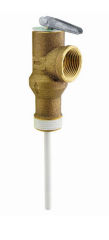 Deb:
Deb:
Thank you for the question.
A typical pressure/temperature relief valve for a water heater, like this Rheem ProTech TPR valve shown here, costs about $25. for the valve alone - not including paying a plumber for installation.
Note that this TPR valve has an extenstion that senses water temperature by being immersed into the hot water tank or calorifier (or geyser) hot water contents.
This valve must therefore be installed at the manufacturer's tapping provided for that purpose at or near the top of the water heater tank.
On 2020-10-06 by Deb
Average cost for thermal pressure relief valves
On 2020-04-03 - by (mod) -
Ramy
By replacing the TPR valve and observing that the new one leaks - i.e. not from the threaded fitting but from the valve's discharge opening or mouth - you've demonstrated that there is an unsafe condition on the water heater itself - an over temperature or over pressure, or possibly a leak due to water hammer or abnormally high water system pressure and the need for a thermal expansion tank on the system.
See details starting at RELIEF VALVE LEAKS
Other diagnosis and repair articles are listed in the "MORE READING" section at the end of this article
On 2020-04-03 by Ramy
I did replacing the temperature pressure valve with a same size but still leaking again
On 2020-02-09 - by (mod) -
Phil
Water heater temperature and pressure relief valves are not adjustable. You don't change or set the relief or release pressure. The standard pressure is typically 150 psi.
On 2020-02-09 by Phil mack
My inlet regulator on my hot water boiler is set at 45lbs, at what pressure should the relief valve be set at.
On 2020-02-08 by (mod)
Joe
Thanks for asking a great question. There's an important point to clarify about the purpose of the discharge tube.
While I haven't seen an explicit prohibition against using flexible copper tubing on a relief valve discharge tube, The building codes don't anticipate every possible dangerous or otherwise are erroneous. Installation that we might come up with.
However in my opinion. A flexile TPR valve discharge tube Is a very bad idea because the flexibility means that the discharge tube could easily be pushed into a position in which, rather than discharging very hot water onto the floor, It could discharge scalding water into the face of someone nearby.
On 2020-02-08 by Joe
Can 3/4 copper flexible ribbed piping, the type you sometimes see installed on the inlet and outlet lines, be used for the TPR valve?
On 2019-03-27 - by (mod) -
A standard TPR for water heaters will be fine - from the article above we have
The standard opening pressure for TP valves on residential water heaters is usually 150 psi, and most water heater tanks also have a standard operating pressure of 150 psi. If the building water supply pressure is above 125 psi, Watts recommends that a pressure-reducing valve be installed to reduce pressure to 40-45 psi so that a standard TP valve set can be used.[10]
On 2019-03-21 by Matthew
If the inlet regulator on a hot water boiler is said to 45 lb at what pressure should the relief valve be set
On 2019-01-28 - by (mod) -
All this sound strange to me. I acknowledge that an expert appliance or water heater repair person or plumber knows things i don't but frankly I can't make any sense out of what you were told.
WhenI first looked at your photo on my smartphone I could not see the smudge that's visible on a larger screen. And I was more suspicious than now after taking a closer look.
In your photo we see a black smudge above the TPR valve (red arrow)
and we can see where your alert technician wiped a finger - or someone did (green arrow).
An air leak up inside the heater insulating jacket might indeed carry soot from an improperly-operating gas burner or oil burner to this opening where on escape a smudge might be left.
So might movement of dirty or dusty air up through the heater and exiting at this opening for other reasons.
You don't tell me what kind of water heater is installed.
Watch out: if there is an improperly operating gas burner at your heater the system could be unsafe, risking dangerous carbon monoxide poisoning.
The possibilities range from a scam - innocent air movement, to an astute technician whom you should buy a steak dinner - if there is an unsafe gas burner or unsafe electrical connection or wiring in your heater.
Hire someone you trust to take a closer look and tell me what is reported and we can comment further.
On 2019-01-11 by April
A tech came out to fix my garbage disposal. Ask to see my hot water heater ( electric). Wiped his finger across the top of temp/pressure valve and said the dirt shows “arching” inside tank, and is a fire hazard. Recommend the entire unit be replaced. Is this accurate, or a scam?
IMAGE LOST by older version of Clark Van Oyen’s useful Comments code - now fixed. Please re-post the image if you can. Sorry. Mo
...
Continue reading at RELIEF VALVES - TP VALVES - topic home, or select a topic from the closely-related articles below, or see the complete ARTICLE INDEX.
Or see RELIEF VALVE, WATER HEATER DIAGNOSTIC FAQs - questions and answers about water heater or geyser TPR valves posted originally on this page.
Or see these
Recommended Articles
- GAS WATER HEATER AUTOMATIC SHUTOFF - temperature operated gas supply shutoff for water heaters, Watts 210-5 series
- HOT WATER PRESSURE EXPANSION RATE - how much does water expand when you heat it?
- HOT WATER EXPANSION TANKS - how to cure the problem of leaks in heated hot water systems, calorifiers, water cylinders
- RELIEF VALVES - TP VALVES - home
- EXPANSION TANK WATERLOGGED, RELIEF VALVE LEAK
- RELIEF VALVE INSPECTION POINTS
- RELIEF VALVE DISCHARGE TUBE
- RELIEF VALVE LEAKS
- RELIEF VALVE LEAK DUE TO EXPANSION TANK
- RELIEF VALVE on STEAMBATH GENERATOR
- RELIEF VALVE, TP VALVE, BOILER
- RELIEF VALVE, TP VALVE, STEAM BOILER
- RELIEF VALVE, TP VALVE TEST
- RELIEF VALVE, WATER HEATER
- RELIEF VALVE, WATER TANK
- THERMAL EXPANSION TPR VALVE LEAKS
- TUNDISH used in PLUMBING
- WATER HEATER PRESSURE-ONLY RELIEF VALVES
- WATER HEATER SAFETY
Suggested citation for this web page
RELIEF VALVE, WATER HEATER at InspectApedia.com - online encyclopedia of building & environmental inspection, testing, diagnosis, repair, & problem prevention advice.
Or see this
INDEX to RELATED ARTICLES: ARTICLE INDEX to T&P RELIEF VALVES
Or use the SEARCH BOX found below to Ask a Question or Search InspectApedia
Or see
INDEX to RELATED ARTICLES: ARTICLE INDEX to PLUMBING SYSTEMS
Or use the SEARCH BOX found below to Ask a Question or Search InspectApedia
Ask a Question or Search InspectApedia
Try the search box just below, or if you prefer, post a question or comment in the Comments box below and we will respond promptly.
Search the InspectApedia website
Note: appearance of your Comment below may be delayed: if your comment contains an image, photograph, web link, or text that looks to the software as if it might be a web link, your posting will appear after it has been approved by a moderator. Apologies for the delay.
Only one image can be added per comment but you can post as many comments, and therefore images, as you like.
You will not receive a notification when a response to your question has been posted.
Please bookmark this page to make it easy for you to check back for our response.
IF above you see "Comment Form is loading comments..." then COMMENT BOX - countable.ca / bawkbox.com IS NOT WORKING.
In any case you are welcome to send an email directly to us at InspectApedia.com at editor@inspectApedia.com
We'll reply to you directly. Please help us help you by noting, in your email, the URL of the InspectApedia page where you wanted to comment.
Citations & References
In addition to any citations in the article above, a full list is available on request.
- [3] Pounds of lime deposited vs. temperature and hot water usage: see Purdue Bulletin #74 (also provided by A.O. Smith in the article below). Purdue's chart shows the number of pounds of lime deposited per year as a function of the water usage in gallons per day, with an assumed 10 grains of water hardness.
- [4] "When, Why, and How to Remove Water Scale from Tank Type Glass-Lined Water Heaters (for non glass-lined tanks, consult water heater manufacturer)" PDF provided by A.O. Smith Water Products Company - hotwater.com/lit/training/4800r9.pdf 800-433-2545 - 01/07/2009.
- Carbon Monoxide Gas Toxicity, exposure limits, poisoning symptoms, and inspecting buildings for CO hazards
- In addition to citations & references found in this article, see the research citations given at the end of the related articles found at our suggested
CONTINUE READING or RECOMMENDED ARTICLES.
- Carson, Dunlop & Associates Ltd., 120 Carlton Street Suite 407, Toronto ON M5A 4K2. Tel: (416) 964-9415 1-800-268-7070 Email: info@carsondunlop.com. Alan Carson is a past president of ASHI, the American Society of Home Inspectors.
Thanks to Alan Carson and Bob Dunlop, for permission for InspectAPedia to use text excerpts from The HOME REFERENCE BOOK - the Encyclopedia of Homes and to use illustrations from The ILLUSTRATED HOME .
Carson Dunlop Associates provides extensive home inspection education and report writing material. In gratitude we provide links to tsome Carson Dunlop Associates products and services.


